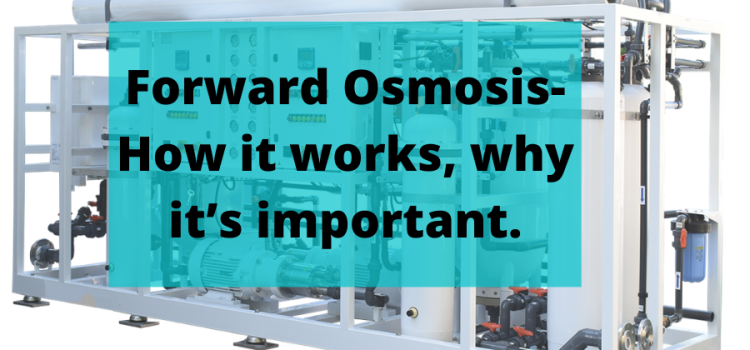How Forward Osmosis Works
Forward Osmosis is a modern water treatment technology that uses a semi-permeable membrane and a draw solution to ensure that water is separated from dissolved solids or impurities. It is different than reverse Osmosis on which hydraulic pressure is used to separate the dissolved solids from water.
To make things simpler, you should remember that Osmosis is a process in which a semi-permeable barrier or membrane is used. In an FO system, the water diffuses across the FO membrane to ensure both sides are at equilibrium. The water diffuses from a lower concentration to a higher concentration.
Forward Osmosis needs less energy as compared to the reverse osmosis process as the pressure needed to force the water through is not high when you use an FO membrane. In an RO system, high pressure is needed to force the water through a membrane. Hence, high-pressure pumps, vessels, stainless steel, and lots of energy is required when an RO system is used. It increases the cost of the system as well as the power bills.
Hence, FO systems consume much less energy than RO systems and help you save on your power bills.
Why Forward Osmosis is Important
Better Sensory Profile
One of the key reasons why FO is important is that it helps preserve the nutrients, color, and sensory profile of water. Most membrane processes are widely accepted as they are good at concentrating liquids with heat-sensitive compounds. Forward Osmosis does better than RO and even thermal evaporation when it comes to preserving the nutrients, color, and sensory profile of water as the concentration is much higher than these options. FO also doesn’t affect the main flavor compounds and lead to browning. Hence, the color and sensory profile of water remain the same.
Money Savings
When the draw water for the FO process is available, the process only needs energy for circulations of two basic liquids, the feed solution, and the draw solution. The process also has a high tolerance for foulants. Hence, the operating costs and maintenance needs of such a water treatment system are minimal. The need for pre-treatment is also low as a FO Membrane is less prone to fouling and plugging. Both these are usually induced due to the pressure used to push water via the FO membrane. Usually, the foulants are compacted in the process. Also, as FO works without the need for hydrostatic pressure, the complications that occur from foulants (in other treatment processes) are low.
These factors ensure that the Forward osmosis (FO) system stays cost-effective and a cheap option for purchase by farmers, small businesses and even households. A system like this is also smaller than evaporators and will help people save some space.
Enhanced Water Output
The water output of this process is also better than many other water treatment technologies. The water that is produced can be used for all purposes. It is also suitable for reuse for cooling tower feed makeup, boiler feed makeup, irrigation, wash-downs, or even diluting waste streams which exceed discharge limits.
Wide Applications
FO can be used to dewater fruits juices and ensure that they retain their original sensory profile, color, and flavor. It can also be used for high-quality concentrated feedstock prior to the spray-drying process during the production of powdered products. FO is also suitable when you want to concentrate proteins from milk, and it’s applicable to heat sensitive and non-heat sensitive proteins. Growers can use this process to convert excess fruit into high-quality concentrate. FO can also help with dewatering the mixtures of water and alcohol.
Wastewater treatment is another good factor as the FO process can be used to concentrate liquid products at a time when clean water for reuse is being produced. As FO has a high tolerance for fouling, it can concentrate wastes that are hard to treat and those which plug other membranes. The treated waste can often be transformed into a high-BTU syrup that is an excellent energy source.
Suitable for Remote Locations
As the costs involved in owning, operating, and maintaining an FO system are low, such systems are ideal for remote locations and isolated areas worldwide. Even the discharge requirements for such systems are low, making them suitable for small businesses and community water needs. These systems are also quite easy to use, and one needs minimal training to operate them effectively. So, anyone can use them efficiently and effectively.
Good for the Future
The first FO system was used in 1977. Since then, efforts have been made to make it more effective. The popularity and scope of such systems have increased in the last decade or so and are expected to increase in the future. The commercial debut of such systems happened years after many other water treatment technologies such as RO were introduced in the market. Still, the FO systems have managed to get the attention of the water treatment companies and customers alike due to the many benefits it offers. The technology will likely be refined further, and AMPAC USA hopes to enhance its FO systems. To know more about this, feel free to call us and let us guide you on how forward Osmosis is beneficial for you and which of our ready to ship systems are ideal for your needs and requirements.
References:
https://www.wateronline.com/doc/forward-osmosis-how-it-works-and-why-it-s-important-0001
https://www.ift.org/news-and-publications/food-technology-magazine/issues/2017/march/columns/processing-forward-osmosis-and-applications-in-industry
https://www.sciencedirect.com/topics/engineering/forward-osmosis
https://www.sbir.gov/content/forward-osmosis-water-purification-membranes-small-operations-0









